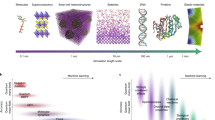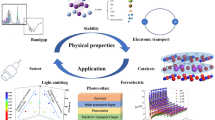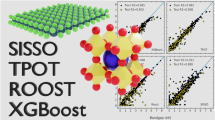Abstract
This article provides a short review of interesting results on application of modelling and computation in understanding and prediction of quantum materials. Modelling and computation are used in understanding structure–property relationship, designing novel functionality in existing materials and prediction of new materials with targeted properties. Examples are drawn from applications in uncovering structure–property relation in high Tc cuprate superconductors, low-dimensional quantum spin systems, engineering cooperative spin crossover phenomena in magnetic hybrid perovskites and coordination polymers, and machine learning assisted prediction of magnetic double perovskites and permanent magnets.

adapted from reference [6].

adapted from reference [10]. (b) The comparison of calculated magnetic susceptibility considering different spin models (shown in lines with different styles) in comparison to experimentally measured data (shown in circles) for Na2V3O7. Figure adapted from reference [11]. (c) Calculated spin wave spectrum for Zn2VO(PO4)2. The colour variation defines the strength of magnetic structure factor S(Q,ω) with lowest strength coloured as black and highest strength coloured as white. Figure adapted from reference [12].

adapted from reference [20]. (b) The crystal structure (top panel) and predicted combined temperature–pressure induced spin-state transitions in bimetallic Fe-Nb coordination polymer with S = 0 low-spin (LS) state of Fe, S = 1 intermediate spin (IS) state of Fe with parallel alignment between Fe and Nb spins, HS-1 state with Fe at S = 2 HS state antiparallely aligned to Nb spin and HS-2 state with Fe at high-spin (HS) S = 2 state parallely aligned to Nb spin. Figure adapted from reference [21].

adapted from reference [23]. (b) DFT calculated electronic and magnetic states of predicted double perovskite compounds. Figure adapted from reference [23]. (c) Machine learning assisted prediction of low-cost rare-earth-transition metal-based permanent magnets (PM). Figure adapted from reference [24].
Similar content being viewed by others
References
Fritjof C 2007 The science of Leonardo; inside the mind of the genius of the renaissance (New York: Doubleday)
Aguado R and Kouwenhoven L 2020 Phys. Today 73 44
Kohn W and Sham L 1965 Phys. Rev. 140 A1133
Shen K M and Seamus Davis J C 2008 Mater. Today 1114
Rybicki D, Jurkutat M, Reichardt S, Kapusta C and Haase J 2016 Nat. Commun. 7 11413
Pavarini E, Dasgupta I, Saha-Dasgupta T, Jepsen O and Andersen O K 2001 Phys. Rev. Lett. 87 047003
Pavarini E, Dasgupta I, Saha-Dasgupta T, Jepsen O and Andersen O K 2020 Phys. Rev. Lett. 124 109701
Lemmens P, Gúntherodtb G and Gros C 2003 Phys. Rep. 375 1
Saha-Dasgupta T 2021 Molecules 26 1522
Das H, Saha-Dasgupta T, Gros C and Valentí R 2008 Phys. Rev. B 77 224437
Saha-Dasgupta T, Valentí R, Capraro F and Gros C 2005 Phys. Rev. Lett. 95 107201
Kar S and Saha-Dasgupta T 2014 Physica B 432 71
Saha-Dasgupta T and Oppeneer P M 2014 MRS Bull. 39 614
Banerjee H, Chakraborty S and Saha-Dasgupta T 2017 Inorganics 5 47
Lichtenstein A I, Zaanen J and Anisimov V I 1995 Phys. Rev. B 52 R5467
Iftimie R, Minary P and Tuckerman M E 2005 PNAS 102 6654
Banerjee H, Kumar M and Saha-Dasgupta T 2014 Phys. Rev. B 90 174433
Weber B, Kaps E S, Desplanches C and Létard J F 2008 Eur. J. Inorg. Chem. 2008 2963
Jain P, Ramachandran V, Clark R J, Zhou H D, Toby B H, Dalal N S et al 2009 J. Am. Chem. Soc. 131 13625
Banerjee H, Chakraborty S and Saha-Dasgupta T 2016 Chem. Mater. 28 8379
Tarafder K, Kanungo S, Oppeneer P M and Saha-Dasgupta T 2012 Phys. Rev. Lett. 109 077203
Vasala S and Karppinen M 2015 Prog. Solid State Chem. 43 1
Halder A, Ghosh A and Saha-Dasgupta T 2019 Phys. Rev. Mater. 3 084418
Halder A, Rom S, Ghosh A and Saha-Dasgupta T 2020 Phys. Rev. Appl. 14 034024
Coey J M D 2011 IEEE Trans. Magn. 47 4671
Acknowledgements
The author acknowledges J. C. Bose National Fellowship (grant no. JCB/2020/000004) for funding. The author gratefully acknowledges contributions from O K Andersen, O Jepsen, E Pavarini, I Dasgupta, R Valenti, H Das, C Gros, S Kar, H Banerjee, S Chakrabarty, P M Oppeneer, K Tarafder, S Kanungo, A Halder, A Ghosh and S Rom for the results discussed in this short review article.
Author information
Authors and Affiliations
Corresponding author
Additional information
This article is part of the special issue on ‘Quantum materials and devices’.
Rights and permissions
About this article
Cite this article
SAHA DASGUPTA, T. Understanding and prediction of quantum materials via modelling and computation. Bull Mater Sci 44, 270 (2021). https://doi.org/10.1007/s12034-021-02588-y
Received:
Accepted:
Published:
DOI: https://doi.org/10.1007/s12034-021-02588-y




